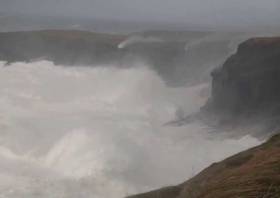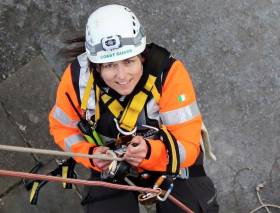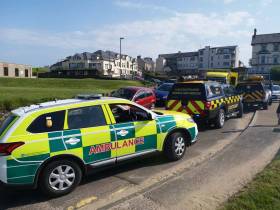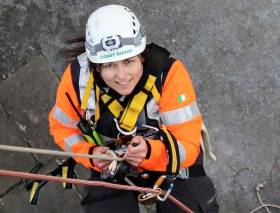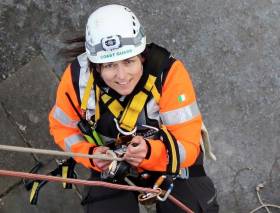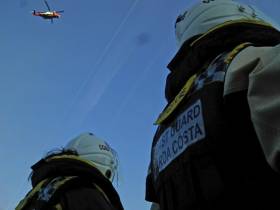Displaying items by tag: Kilkee
Seaweed Picker Dies After Being Swept Out to Sea Off West Clare
RTÉ News reports that a man in his 30s has died after he was swept out to sea while picking seaweed on the West Clare coast on Sunday (23 January).
The man’s body was recovered in a multi-agency response on Sunday afternoon less than an hour after the alarm was raised.
It’s understood that the man had been picking seaweed on the shore near Farrihy Bay north of Kilkee when he lost his footing and fell into the water.
Elsewhere, a surfing instructor has urged for greater awareness of water safety after his rescue of a father and son who capsized while kayaking in Portrush in Northern Ireland on Sunday.
Dave Hamill told the Belfast Telegraph that the pair were “humbled” after being caught unawares by a rip current, saying that “is not the first time people have gotten into difficulty from lack of water safety awareness”.
He added: “It’s a scary world and it’s the sort of story that needs more attention for sure.”
Man Dies After Being Swept Into Sea Near Kilkee
BreakingNews.ie reports that a sea angler has died in an incident on the Co Clare coast yesterday afternoon (Saturday 26 October).
The man, believed to be a Polish national in his 40s, had been fishing with another man at Castle Point near Kilkee when he was hit by an unexpected wave and swept into the sea.
The alarm was quickly raised while the man’s companion attempted to rescue the casualty but to no avail in conditions described as “rough”.
The incident occurred close to where a Hungarian man was swept into the ocean from sea cliffs in January last year.
BreakingNews.ie has more on the story HERE.
#Coastguard - There was no evidence of effective management at Kilkee’s coastguard station when volunteer Caitríona Lucas died during a rescue operation almost two years ago, according to a draft report into the incident.
The Irish Times has details of the draft report from the Marine Casualty Investigation Board (MCIB), which adds that the RIB on which Lucas was travelling before it capsized on 12 September 2016 was being used outside of the Irish Coast Guard’s own operational limits.
Parallels were also drawn to a similar incident two years prior involving a coastguard RIB in a “surf zone” near Dingle, which prompted a series of recommendation that were not “fully implemented” by the Irish Coast Guard, according to the MCIB.
The Irish Times has much more on the story, while Lorna Siggins also writes on how Lucas’ death occurred amid a tumultuous time for the Co Clare coastguard unit.
Rip Current Rescue Launch For Coleraine Coastguard
#Coastguard - Coleraine Coastguard headed to the rescue of a man and three children caught in a rip current at Castlerock over the weekend following the Portrush Raft Race.
According to BBC News, the four were on bodyboards when they were swept away by the current on Saturday 26 May - though they managed to get back to shore before the coastguard team arrived.
None needed hospital treatment, however they were attended to by the NI Ambulance Service for shock and the cold, as well as for swallowing sea water.
As reported earlier on Afloat.ie, Bundoran RNLI were involved in the rescue of a man and boy caught in a rip current off Bundoran beach yesterday (Sunday 27 May).
Elsewhere, the Irish Examiner reports that a man was airlifted to hospital after falling overboard from his boat off the Clare coast yesterday afternoon.
Irish Coast Guard units from Kilkee and Doolin as well as the Rescue 115 helicopter from Shannon were dispatched to the scene, where the man had fallen from a dive boat and was unable to leave the water due to an injury.
The Irish Examiner has more on the story HERE.
Man Dies After Being Swept Into Sea From Clare Coastal Cliff
#Creeragh - Independent.ie reports that a man has died after he was swept into the sea by an unexpected wave near Kilkee in Co Clare yesterday (Saturday 13 January).
The 30-year-old man, believed to be a Hungarian national resident in Galway, is understood to have climbed down to the base of a cliff in Creeragh to take photos when he was washed away.
Emergency services were alerted immediately, and the Shannon-based Irish Coast Guard helicopter Rescue 115 quickly located the casualty and winched him from the water.
However, the man was later pronounced dead at University Hospital Limerick.
Protest In Kilkee Over Reduced Coastal Rescue Service
#Coastguard - Irish Coast Guard management faced a protest march at the weekend over Kilkee’s lack of a full rescue service — and one restricted further since the death last year of coastguard volunteer Caitriona Lucas, as The Irish Times reports.
Locals were demonstrating for the second time this month over what former mayor Manuel di Lucia said was an issue that dated back to when the Irish Coast Guard took over the Co Clare’s town’s community lifeboat in 2013.
The paper’s sources allege inconsistent management and a lack of training and qualified crew compounded the situation that led to the death of Lucas, when the RIB she was travelling in capsized during a search operation. Her bravery at sea was recognised with a posthumous award of the State's highest honour earlier this month.
The Irish Times has much more on the protest, which came on the same weekend that Lucas and the lost crew of Rescue 116 were remembered at a memorial service for those who died in the Cleggan Bay Disaster in 1927.
Investigation Ongoing Into Death Of Coastguard Volunteer Caitriona Lucas
#MCIB - An official investigation into the death of coastguard volunteer Caitriona Lucas remains ongoing, as the Marine Casualty Investigation Board (MCIB) confirms.
Lucas, a volunteer for the Irish Coast Guard’s Doolin unit, died on 12 September 2016 during a search operation for a missing person in Kilkee, when the RIB in which she and two other volunteers were travelling capsized in a heavy swell.
The MCIB’s interim report outlines the details of the day in question. Investigators’ analysis, conclusions and recommendations will be reserved for the final report.
Body Recovered In Search For Missing Teacher Off Kilkee
#Kilkee - BreakingNews.ie reports that a body was recovered yesterday (Saturday 24 September) off Kilkee in the search for missing teacher David McMahon.
Hundreds had been involved in the search for the school teacher, who was last seen on 9 September, according to Independent.ie.
The discovery yesterday afternoon came 12 days after the death of Irish Coast Guard volunteer Caitriona Lucas in the same area.
That tragedy occurred when the RIB she and two other coastguard volunteers were on board was flipped over in a heavy swell, three days into the search operation for McMahon off the Co Clare coast.
Coastguard Member Dies During Search Off Kilkee
#Coastguard - RTÉ News is reporting that a member of the Irish Coast Guard has died after a rescue boat overturned during a search for a man missing of Kilkee this afternoon (Monday 12 September).
Two other coastguard crew were recovered from the water and taken to hospital after the RIB all three were onboard flipped over in a heavy swell.
More on this story as it develops.
Clare County Council, supported by An Garda Síochána, The Irish Coastguard and Irish Water Safety, has announced the installation of marker buoys delineating the speed limit for powered craft in the vicinity of Kilkee pier.
The buoys, which have been acquired from LCF Marine of Bere Island, are being installed on behalf of Clare County Council by The Irish Coastguard and Kilkee Sub Aqua Club.
The recently approved County Clare Beach Bye-Laws 2016 specify that operators of personal watercraft and fast power craft must observe a speed restriction of 6 knots from the water line to 300m seaward from all beaches and should not operate in the proximity of swimmers, except in the event of an emergency. Any vessel not observing the speed limit is liable to prosecution.
The installation of the marker buoys coincides with the commencement of full-time lifeguard cover during July and August at Kilkee and 8 other local Blue Flag Beaches, as well as at the Green Coast beaches of Bishops Quarter (Ballyvaughan) and Seafield (Quilty).
Clare McGrath, Clare Water Safety Development Officer is encouraging water users, particularly operators of power craft, to familiarise themselves with the newly introduced County Clare Beach Bye-Laws 2016.
“The Bye-Laws are aimed at ensuring that everyone who visits County Clare’s beaches can continue to enjoy themselves in an environment that protects their safety and the safety of those around them,” stated Ms. McGrath.
She continued, “To protect other water users, operators of boats and jet skis should obey speed limits when launching or retrieving their vessel. The Bye-Laws stipulate that users of personal watercraft or fast power craft should act in such a manner as not to cause annoyance to any person using a beach or swimming in the water or to disturb naturally occurring flora and fauna. Furthermore, people must wear correctly maintained and fitting lifejackets that are suitable for the activity and to ensure their craft is fit for purpose. Under no circumstances should alcohol be consumed prior to entering the water.”
The County Clare Beach Bye-Laws 2016 may be viewed at www.clarecoco.ie.
Full-time lifeguard cover is being provided daily during July and August from 11.00am to 7.00pm at Clare’s Blue Flag beaches in Spanish Point, Lahinch, Fanore, Whitestrand Doonbeg, Ballycuggeran, Mountshannon, Cappagh Pier, Kilkee and Whitestrand Miltown Malbay, as well as at Bishops Quarter (Ballyvaughan) and Seafield Quilty.


























